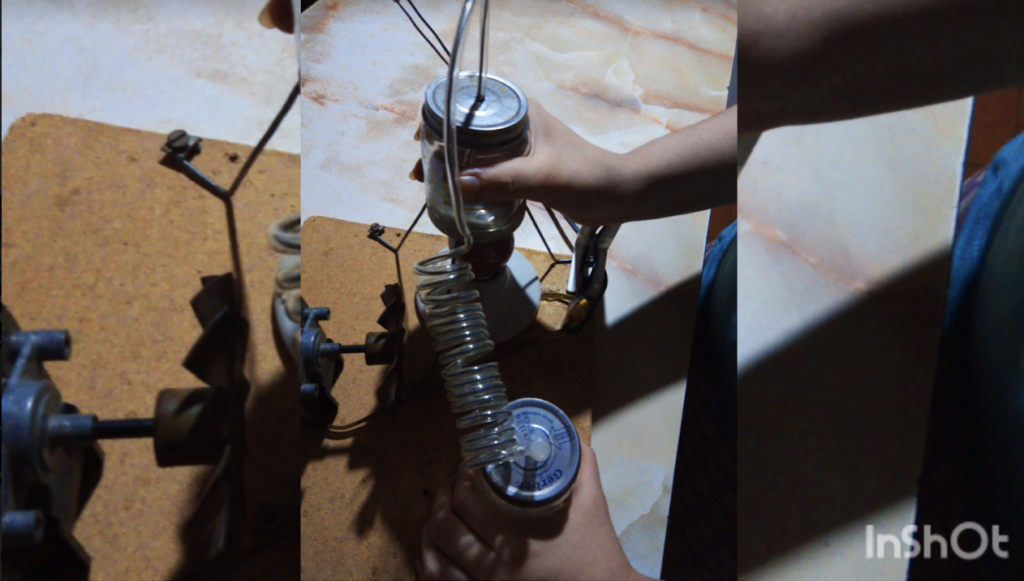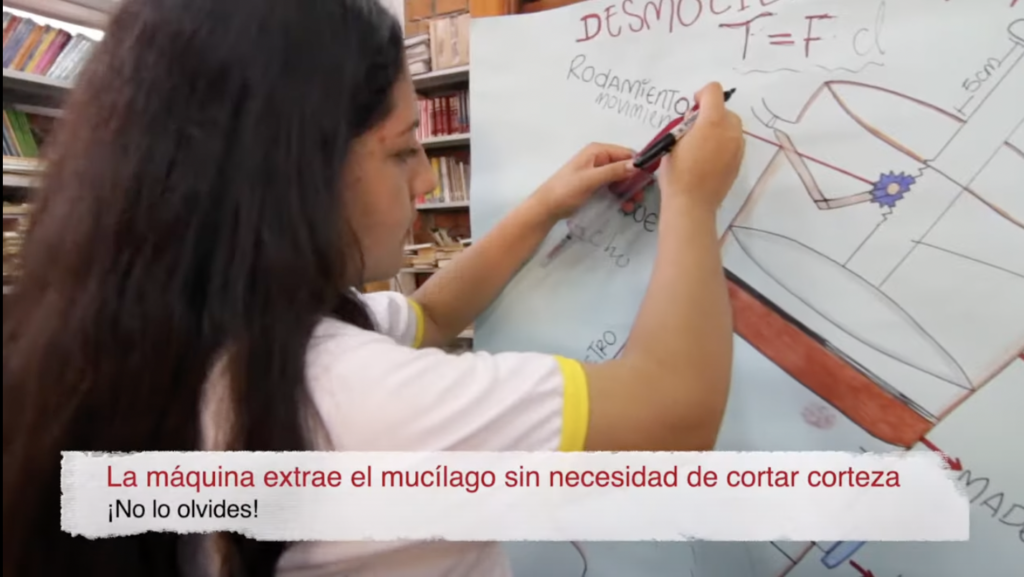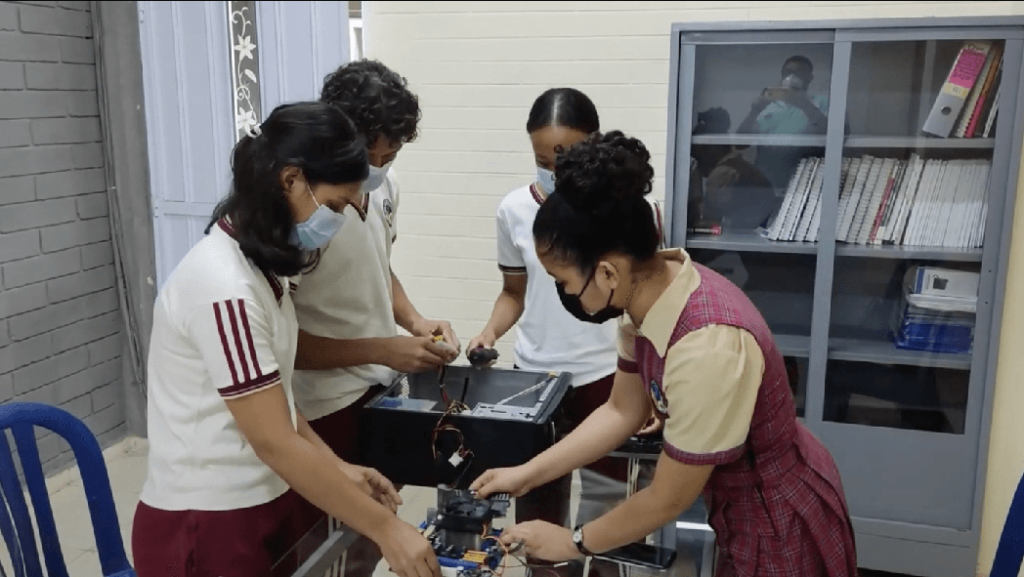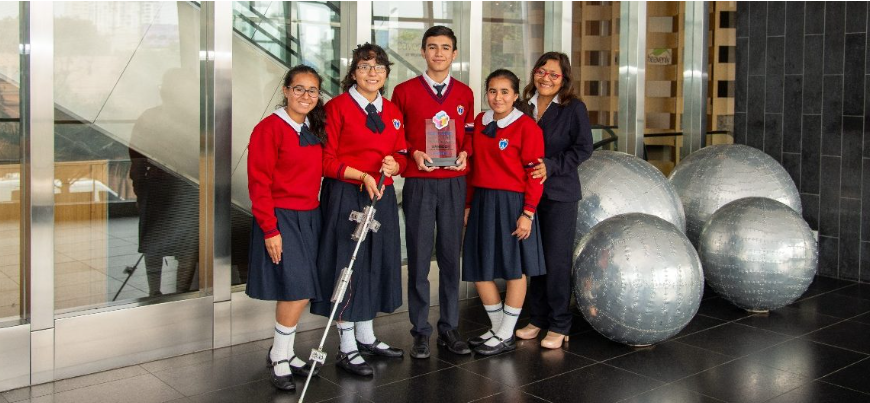Project gallery

Community plant for the preparation of medicines
Report sent by the Teacher
Mariela Travieso G.School
Unidad Educativa Valle Turmero y Unidad Educativa Bicentenario de las Independencias Turmero, Aragua, Venezuela, VenezuelaProject team composition
Andrea Rocío Travieso González, Joana Nazaret Fuentes Rubio, Francisco José Fuentes Rubio, Marycarmen Linares Noriega
Age of students
15 to 17 years oldOther areas of knowledge
History, Geography, Arts (visual arts, film, music, etc.)Project duration
One semesterSoft skills
Collaboration, Communication, Creativity, Critical thinkingSTEM areas
Sciences, TechnologyEmpathy: learning from people’s values and needs
Project objective, problem to be solved, and main actions
The main objective of the project was to provide a tool to the community, especially to the sector with fewer economic resources, so that in a situation of scarcity, it allows the availability of alternative natural medicines, made by themselves, using local plants with properties, and without any knowledge; prior knowledge of botany, pharmacology, or chemical formulation.
Venezuela has been experiencing a strong economic crisis in the last three years, motivated by the international blockade on imports and also by the pandemic. Due to this, many pharmaceutical companies, both importers and drug manufacturers, face many problems daily to obtain the inputs and raw materials they work with and, at best, also experience an indiscriminate increase in their costs.
Consequently, this situation has generated enormous difficulty in pharmacies to meet the demand of the population; especially in sectors with the most vulnerable socioeconomic conditions, which cannot have access to medical treatment; either because of its high prices or simply because it is scarce. Therefore, it is necessary to have other alternatives that guarantee these people the possibility of treatment, quickly and effectively. In this sense, plants emerge as an economic, ecological, and self-sustainable alternative; as they not only represent the most abundant and accessible source of pharmacologically active principles that exist but are also easily available to those who need to use them.
I must say, given the initiative proposed by the boys, (which in this case was to help the community with fewer resources to have access to medicines) that, in our country, the distribution of medicines (especially those used in the treatment of chronic diseases) has become very difficult. It occurred to the boys that if they could develop a system or program that would teach the community how to make their medicines, using what was available in their environment, such as plants, then they could have access to treatment.
To validate the boys’ proposal, we chose to conduct interviews and small surveys in the community, which gave us the certainty that we were facing a real and current problem. They consisted of a group of simple questions and answers:
1) Did you fail to comply with medical treatment or purchase any medication, due to the lack of a high price?
2) Would you agree to change the chemical treatment for a natural alternative, healthier and made with plants?
3) Do you know how to manufacture a natural product that serves as an alternative treatment for any disease? Could you name any?
From the sample of people surveyed, positive and negative responses were weighted. When the young project leader and her colleagues approached me, the first thing we did together was to check if there was a problem in the community and if it corresponded to their proposal. We conducted a small statistical study of a representative sector of the population that included interviews with randomly selected people on the street, and also in a neighboring community (in extreme poverty).
They were classified by age and sex, and from there, several questions were asked, such as the diseases that most affected them, the frequency of their medical appointments, the monthly budget invested in medicines, etc. This gave us the information necessary to identify the need and thus validate the initiative.
From that moment on, we started to submit the idea to detailed and precise scrutiny, using methodological tools such as Canvas and Design Thinking, thanks to the Academia 24 sessions. This made us restructure the approach, which was initially very generalized and thus be able to define a possible answer or workable solution in the shortest possible time. Besides, we also started deep documentary research on the subject, which involved a bibliographic review on pharmacognosy, some statistical data, ancestral medicine, and natural medicines, as well as scientific publications of similar works developed at national level and international level.
The project was the idea of the young people, who later came to me. I only lent them my room where I give private lessons to get to know them, as the young people, in this case, had previously organized themselves. After one of them submitted the idea to the Solve for Tomorrow platform and was chosen as a semi-finalist, they contacted me and asked me to be their mediator as due to school holidays they were out of school and also knew that I knew about the topic of their proposal.
Definition: better understanding of the challenges
Deepening into the issue and involvement of the school and local community
Once it became clear what challenge or project we were going to work on, we had to do an exhaustive investigation and review of the matter; which included checking if there was any similar work; to our surprise, we found that in an MIT investigation had tried to do the same thing, but with chemical drugs like anxiolytics and barbiturates. This gave more impetus and interest to our research. Specialists in the pharmaceutical, herbal and chemical fields were also consulted.
Immediately after both, the proposal and the group’s participation were accepted, each young person notified their school (since it belonged to three different educational institutions) and their respective families who, as they were minors, proceeded to give their written consent to their participation.
Some community organizations welcomed the initiative, providing information on local plants and expressing interest in piloting the project in the community.
Ideation: developing creative solutions
The development of the solution
When it was decided what would be the definitive approach to the problem, a work plan was prepared, which included schedules for two weekly meetings, established based on the activities and school schedules of the participants. In these meetings, worktables were held so that everyone could present and publicize the research they conducted individually at home.
In this sense, many dynamics had to be developed together such as brainstorming, to evacuate all the information collected, which was scrutinized using the techniques and methodologies learned in the Canvas and Design Thinking workshops, which the competition organization provided.
Thanks to this systematization, it was possible to discover that our model was not the one that best responded to the need initially raised. So we had to go through all the steps again, to restructure the concept we had, and rethink both the project idea and the pilot design.
We went from proposing the construction of a small but complex natural drug synthesizer unit to designing an information system, easily manageable and that we call an “expert program”, as well as a scale model of a homemade distiller, to conduct the manufacturing craft. of our alternative medicines.
To reach this point, some interviews were also scheduled with different professionals in the areas of programming, botany, and chemical-pharmaceutical formulation, who provided their collaboration through a series of microclasses given to children, with which they cleared all their doubts. be answered, facilitating the elaboration of the proposal and the elaboration of the pilot.
In total, it took about 4 and a half months of work to get the final sketch, and then just over a month to materialize it in a viable way.
Prototype: making ideas tangible
The construction of the prototype
It was developed an expert program and a small fully functional still model; which was demonstrated to the Solve for Tomorrow community and also a short presentation (after the contest ended) to some neighbors representative of the community where we applied the study that motivated our project

Test: putting ideas out into the world
Evaluation of the process and the developed solution
As it was the first time we worked together as a team, at the beginning I applied a small diagnostic evaluation test to the boys, which allowed me to know for sure the level of knowledge that each one had on the subject, as well as where I would have to reinforce the knowledge.
We also build together a matrix with each person’s strengths and/or weaknesses. This later allowed us to better distribute everyone’s responsibilities and work.
Finally, we also apply feedback at the end of the national and regional assessment, respectively, to detect flaws and correct them, with a view to future participation. Likewise, the achievements were congratulated, thus reinforcing the positive in both individual and group performance.
Reflections and pedagogical practices
The value of participating in Samsung Solve for Tomorrow
Participating in Solve For Tomorrow was a great experience both academically and personally, which gave me the opportunity as a teacher to link the teaching of chemistry with creativity to develop an idea with social significance from scratch. Going to the communities to investigate their needs with the children meant establishing direct contact with the reality of the country and making them aware of the problems. In addition, the tutorials received from Academia 24 and the Samsung company were extremely valuable. I must say that we were taught to think from the materialization of projects, which at a time and moment when it is necessary to stimulate the culture of entrepreneurship in the new generations, is a tool for personal and social development.
Achievements and advances perceived by the teacher, throughout the process
I think the biggest achievement was getting students excited about science like chemistry, and making them understand the fact that it’s not scary, it’s fun. It’s gratifying to see their initiative when they’re working on their projects. It is even surprising how the idea of putting them to compete in the classroom arouses the interest even of students who are usually the least favored in terms of academic average, and who are usually the ones who most surprise you in this type of activity.
Challenges faced
In general terms, and I think I speak on behalf of all the teams that participated for Venezuela, the contest was a challenge for being new or pioneering in our country. First, getting young people interested in participating in the project was a big challenge; because in everyone there was the fear of not being up to the required knowledge and then failing. It was also very difficult to make them dare to be creative and propose original things, since traditionally in Venezuela science is taught with a purely academic interest, not a practical one. We have an educational system, where the student is formed more with the purpose of learning than creating. So, the fact of trying to adapt the experiences of other countries to our dynamics was already a challenge in itself.
Over the years and with the consolidation of Venezuelan participation, everything will become easier, and more fluid. The main difficulty for us has been the fact that the country is experiencing a situation of commercial isolation, which prevents many companies from conducting their activities. However, I am a witness to the seriousness and commitment of the Samsung company to the SFT contest, as they resolved all situations very efficiently, allowing Venezuela to say that it is always present.
Learning incorporated into the teacher’s routine and practice
In recent years, in Venezuela, emphasis has been placed on the inclusion in the curriculum of secondary and general education in Venezuela (from the 3rd to the 5th year of secondary education) for subjects such as Chemistry, objectives that seek to make the student understand the importance of scientific knowledge to live well. This refers to reinforcing in young people that they can apply the concepts acquired during the course daily, such as: teaching the contribution of chemistry in areas such as food or medicine.
My personal experience through the project we presented for the competition allowed me to show my students that what they learned in the classroom can be applied to develop small entrepreneurial projects. I think that the sciences, in my case Chemistry, should not be seen as something abstract, difficult, disconnected from the world, and impenetrable. On the contrary, our children must be taught to always see the practical side of STEM.
In this sense, I use this idea as part of the evaluation strategy. At the end of each course, I ask them to emphasize projects where chemistry is linked to ecology, food, etc.; how to develop a natural cosmetic by hand and then display it. These types of assessments are very attractive to them and have a high participation rate among students.




